Bee hive stand plans are essential for elevating hives, protecting them from pests, and improving accessibility. PDF guides offer detailed designs, materials, and tips for DIY construction, ensuring durability and functionality while keeping bees safe and thriving.
1.1 Importance of Hive Stands in Beekeeping
Hive stands are crucial for protecting hives from pests, moisture, and weeds. They elevate the hive, making it harder for skunks and other predators to access. Stands also improve accessibility for beekeepers, reducing strain during inspections. By keeping hives off the ground, stands prevent dampness and promote a stable, level base, ensuring healthier bees and more efficient hive management.
1.2 Overview of DIY Hive Stand Plans
DIY hive stand plans provide a cost-effective and customizable solution for beekeepers. Using materials like 2x4s or 4x4s, these plans often include step-by-step instructions for cutting, assembling, and leveling the stand. They cater to various hive types, such as Langstroth or Top-Bar, and may incorporate optional features like frame rests or slopes. Many plans emphasize durability, ease of assembly, and adaptability to different apiary needs, making them accessible for beekeepers of all skill levels.
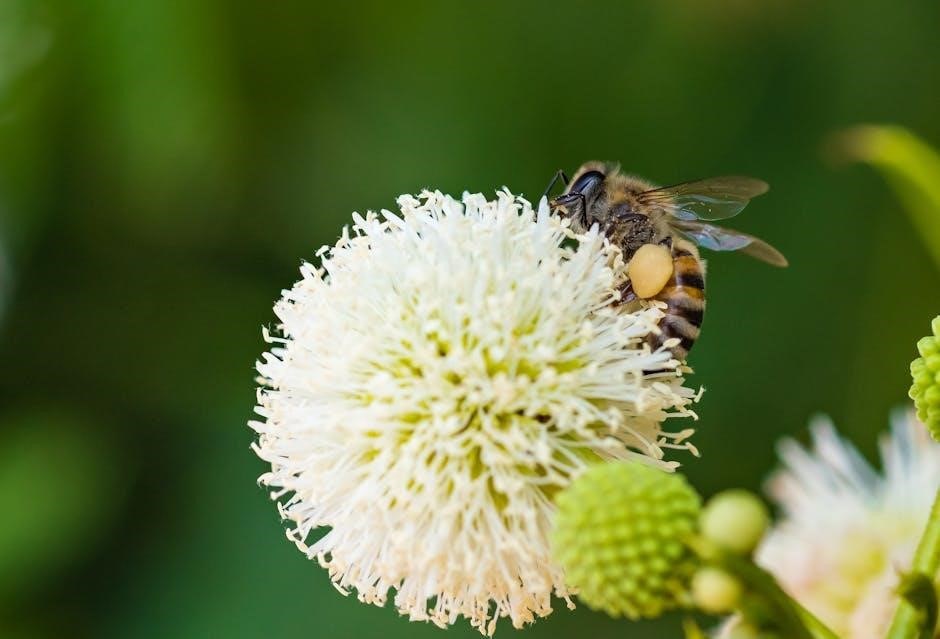
Materials and Tools Needed for Building a Hive Stand
Building a hive stand requires sturdy materials like 2x4s or 4x4s, deck screws, and weather-resistant wood. Essential tools include a drill, saw, and measuring tape for precise cuts and assembly, ensuring a durable and stable stand for your hives.
2.1 Lumber Requirements (e.g., 2x4s, 4x4s)
Pressure-treated 2x4s and 4x4s are ideal for hive stands due to their durability and resistance to rot. Use 8-foot-long posts for legs and 2x4s for framing. For added strength, 2×6 boards can be used for frame rests. Ensure lumber is weather-resistant to withstand outdoor conditions and support the weight of hives safely, providing a sturdy base for your beekeeping setup.
2.2 Fasteners and Hardware
Use weather-resistant fasteners like 10-inch deck screws, galvanized lag screws, or carriage bolts for assembling hive stands. 2-1/2″ deck screws are ideal for securing frame rests and supports. Ensure all hardware is rust-resistant to withstand outdoor conditions. Avoid using nails, as they can split the wood. Pre-drill holes to prevent splitting and use washers for added stability and durability in the construction of your hive stand.
2.3 Optional Features (e.g., Slope, Frame Rests)
Adding a slight slope to your hive stand improves water runoff and prevents pooling. Incorporate frame rests on both sides, spaced 5 inches from the ends, to provide a convenient place for holding frames during inspections. These features enhance functionality, making hive management easier and more efficient while maintaining hive health and accessibility for beekeepers.
Step-by-Step Construction Guide
Consider adding a slope for water runoff and frame rests for convenient frame placement during inspections; These features enhance functionality, making hive management easier and more efficient while maintaining hive health.
3.1 Preparing the Site for the Hive Stand
Ensure the site is level and clear of debris, weeds, or obstructions. Choose a spot with good drainage to prevent water pooling. Position the stand to face east or southeast for optimal sunlight; Avoid low-lying areas prone to flooding. A well-prepared site ensures stability, prevents pests, and promotes healthy hive conditions. Proper positioning also enhances accessibility for regular inspections and maintenance.
3.2 Cutting and Assembling the Frame
Cut the lumber according to the plans, ensuring precise measurements. Assemble the frame using weather-resistant screws or nails. Start with the base, then attach the side rails and supports. Use clamps to hold pieces in place for accurate alignment. Sand all edges for safety and durability. A sturdy frame is crucial for supporting the hive’s weight and withstanding environmental stressors over time.
3;3 Attaching Legs and Supports
Attach legs to the frame using bolts or screws for stability. Ensure legs are level and evenly spaced. Add supports between legs for extra rigidity, especially for multi-hive stands. Use pressure-treated wood for legs to prevent rot. Double-check all connections for tightness and durability. Properly secured legs and supports ensure the hive stand remains stable and level, protecting the hives from tipping or shifting over time.
3.4 Final Assembly and Leveling
Assemble all components and ensure the hive stand is level using shims or adjustable feet. Check the frame alignment and tighten all connections. Place the hive boxes on the stand and verify stability. Make any necessary adjustments to ensure the stand is even and secure, providing a safe and stable platform for the bees to thrive. Proper leveling prevents hive damage and ensures easy access for beekeepers.
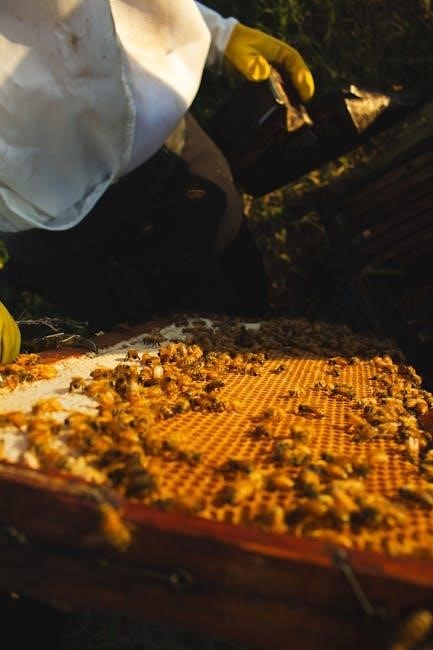
Design Considerations for Hive Stands
Designing a hive stand involves balancing height, stability, and space for multiple hives. Ensure the stand is durable, rot-resistant, and suitable for your local climate to protect your bees effectively.
4.1 Height Recommendations for Easy Access
The ideal hive stand height ranges between 16 to 24 inches, promoting easy access for beekeepers while keeping hives out of reach for pests like skunks. A lower height can prevent grass and weeds from growing underneath, reducing moisture issues. Ensure the stand is level to maintain hive stability and proper functionality, making inspections and hive management more efficient for beekeepers of all experience levels. This height also helps in minimizing strain on the back during routine checks and honey extraction, ensuring a comfortable working experience. Proper elevation further protects the hive from flooding and damp ground conditions, which can damage the hive structure and harm the bees. By adhering to these height guidelines, beekeepers can create an optimal environment for their colonies to thrive. Additionally, a well-elevated hive stand can improve airflow around the hive, which is crucial for maintaining healthy bee activity and preventing the onset of diseases. Overall, the height of the hive stand plays a critical role in both bee health and beekeeper convenience, making it a key consideration in hive stand design. Beekeepers should also consider the specific needs of their bees and the local climate when determining the optimal height for their hive stands, as these factors can influence the overall effectiveness of the stand. Furthermore, ensuring the hive stand is sturdy and can support the weight of the hive and its components is essential for maintaining stability and preventing any potential hazards. A well-designed hive stand not only enhances the accessibility of the hive but also contributes to the overall success of the beekeeping operation by providing a safe and secure environment for the bees. Therefore, careful consideration of the height recommendation is vital when building or selecting a hive stand to maximize both functionality and bee health. The height should be such that it allows for easy manipulation of hive boxes and frames, reducing the physical strain on the beekeeper and ensuring efficient hive management. Moreover, the height should be appropriate for the beekeeper’s stature, allowing them to work comfortably without bending or reaching, which can lead to fatigue and accidents. In conclusion, the height of a hive stand is a fundamental aspect of its design, directly impacting both the well-being of the bees and the ease of operation for the beekeeper. By choosing the right height, beekeepers can create a more efficient and enjoyable beekeeping experience while safeguarding their colonies from potential threats. This attention to detail in hive stand design underscores the importance of thorough planning and consideration of various factors to ensure optimal results in beekeeping endeavors. Ultimately, a hive stand built with careful attention to height recommendations will prove to be a valuable asset for any beekeeper, offering numerous benefits that contribute to the success and sustainability of their apiary. The information provided in bee hive stand plans PDFs can serve as a comprehensive guide, offering insights and best practices for constructing hive stands that meet these critical design considerations. By following these guidelines, beekeepers can ensure their hive stands are both functional and beneficial for their bees, leading to a more productive and rewarding beekeeping experience. In summary, the height of a hive stand is not merely a matter of preference but a crucial design element that significantly influences the health and productivity of the bee colony, as well as the efficiency and safety of the beekeeper’s workflow.
4.2 Space Allocation for Multiple Hives
Proper space allocation is crucial when building stands for multiple hives to ensure easy access and prevent overcrowding. A minimum of 12-18 inches between hives is recommended to allow comfortable inspections and honey extraction. This spacing also reduces competition between colonies and minimizes pest issues. Hive stands designed for multiple hives should include a sturdy frame to support the weight of several boxes safely. Additionally, consider the layout to facilitate workflow and ensure adequate ventilation for healthy bee activity. This practical approach ensures efficient hive management and promotes a thriving apiary environment.
4.3 Ensuring Stability and Level Ground
Stability and level ground are vital for hive stands to prevent hive damage and ensure bee safety. Use a spirit level to confirm evenness and secure the stand on firm, drained soil. Adjustable legs or shims can compensate for uneven terrain, ensuring the hive remains stable. A stable stand protects the hive from tipping and reduces stress on the bees, promoting a healthy and productive colony environment.
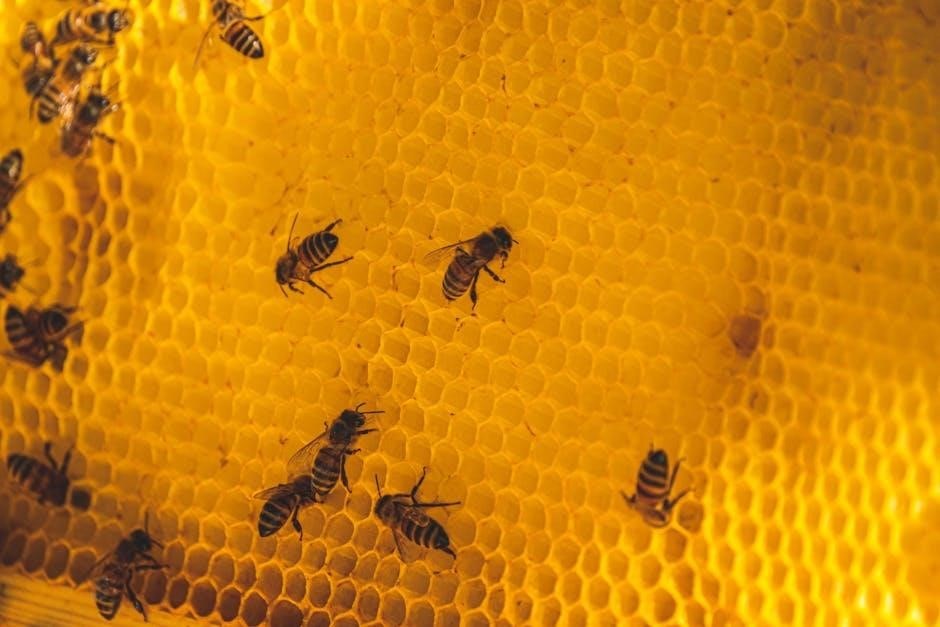
Benefits of Using a Hive Stand
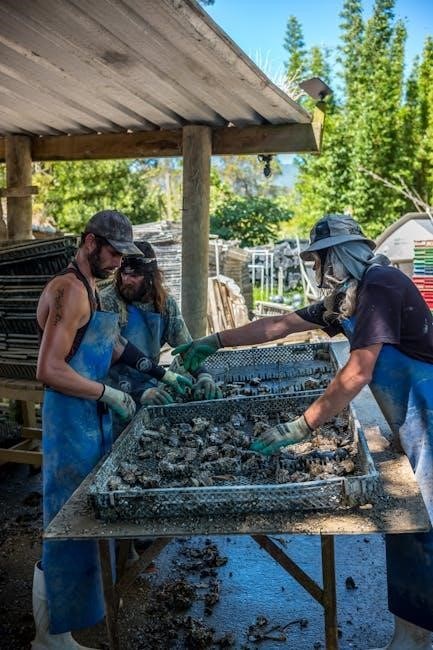
Hive stands elevate hives, protecting them from pests and moisture, while improving accessibility for beekeepers; They also create a stable environment, reducing stress on the colony and enhancing productivity.
5.1 Protecting Hives from Pests and Predators
Elevating hives with stands deters pests like skunks, mice, and ants, reducing damage and stress on the colony. Height creates a natural barrier, discouraging predators from accessing the hive, thus safeguarding the bees and their habitat. This simple yet effective method enhances hive security and promotes a healthier beekeeping environment overall.
5.2 Improving Hive Accessibility for Beekeepers
Hive stands enhance accessibility by elevating hives to a comfortable working height, reducing strain on the back and knees. This elevation simplifies inspections, hive management, and frame handling. Additionally, stands often include features like frame rests, providing a convenient place to set frames during inspections. These designs make beekeeping more efficient and ergonomic, especially for those managing multiple hives or working for extended periods.
5.3 Reducing Moisture and Weed Issues
Hive stands help keep hives off the ground, reducing moisture accumulation and preventing rot. By elevating the hive, weeds and grass are less likely to grow around the entrance, minimizing pests and creating a cleaner environment for bees. This design ensures better airflow and drier conditions, promoting healthier hive operations and easier management for beekeepers.
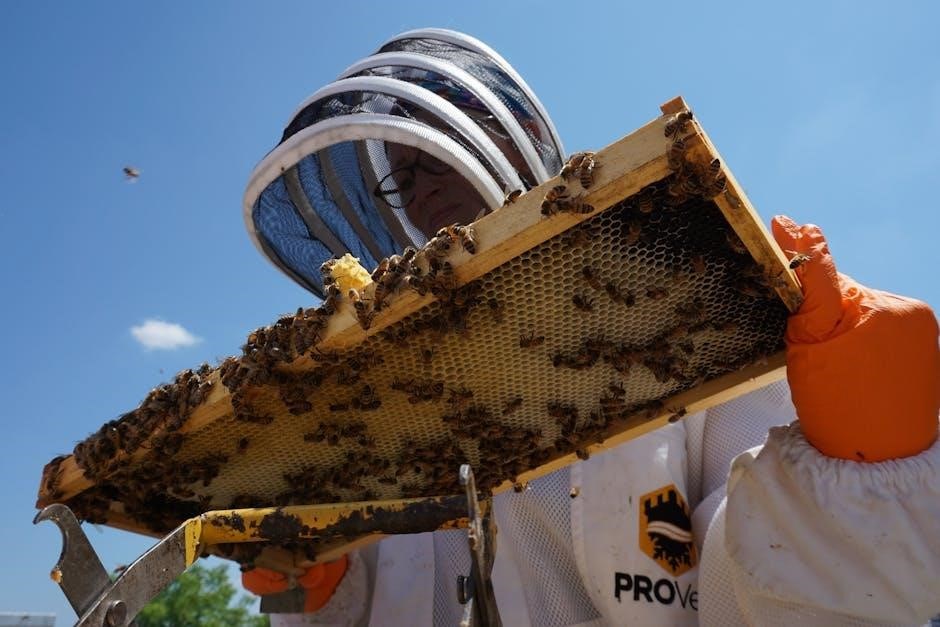
Tips for Building Hive Stands for Different Hive Types
Customize stands for Langstroth, Top-Bar, or Warre hives, ensuring proper height and frame spacing. Use sturdy materials like 2x4s or 4x4s for durability and adjust designs to suit hive-specific needs.
6.1 Langstroth Hive Stands
Langstroth hive stands are designed to support standard 10-frame hives, often built using durable 2×4 or 4×4 lumber. Plans typically include a sloped front for frame rests and adjustable legs for leveling. Ensure adequate spacing for hive management, with stands accommodating multiple hives side-by-side. PDF plans often provide precise measurements and assembly instructions to ensure stability and ease of use.
6.2 Top-Bar Hive Stands
Top-bar hive stands are tailored for horizontal hives, offering simplicity and accessibility. Plans often feature a low profile with adjustable legs and a frame rest area. Constructed from materials like recycled wood or 2x4s, these stands emphasize ease of assembly and customization. PDF guides provide detailed instructions for building stands that cater to the unique needs of top-bar hive systems, ensuring durability and functionality.
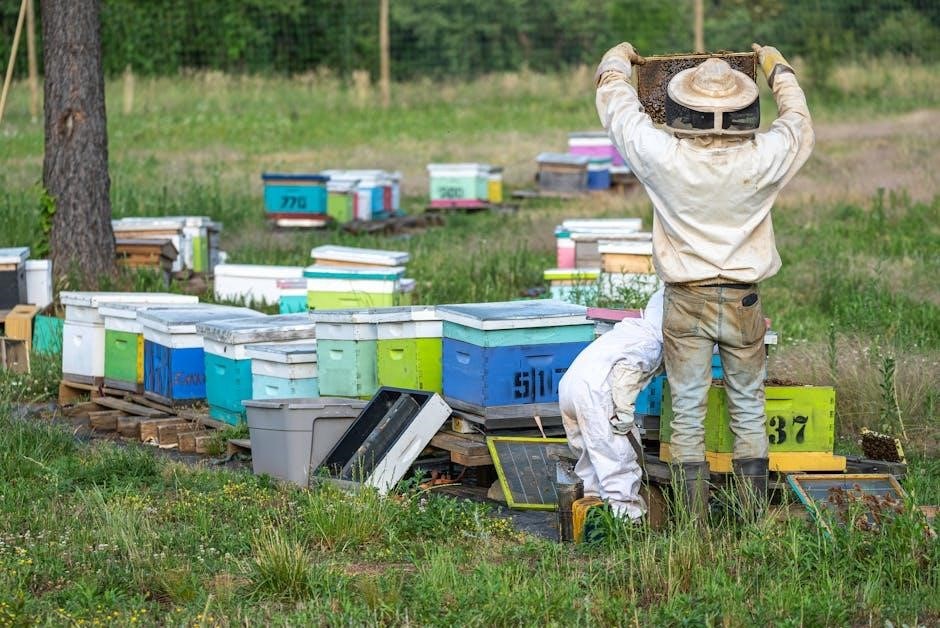
6.3 Warre Hive Stands
Warre hive stands are designed for the compact, vertical nature of Warre hives, emphasizing simplicity and natural beekeeping. Plans often specify lightweight materials like cedar for durability and rot resistance. The stand’s low height facilitates easy inspections and protects the hive from pests and moisture. PDF guides provide detailed instructions for constructing Warre stands, ensuring compatibility with this unique hive style and its focus on natural bee management.
Advanced Features for Hive Stands
Advanced hive stands often include features like built-in frame rests or slopes and additional storage compartments for equipment, enhancing functionality and convenience for beekeepers.
7.1 Adding a Slope for Frame Rests
Adding a slope to your hive stand provides a convenient resting area for frames during inspections. This feature enhances accessibility and helps maintain hive organization. A subtle incline ensures frames stay in place, while the stand’s height, typically around 16 inches, prevents grass and weeds from growing underneath and deters pests like skunks.
7.2 Incorporating Storage Space
Incorporating storage space into hive stands is a practical upgrade for beekeepers. This feature allows for keeping tools, hive boxes, and protective gear nearby, enhancing efficiency. Designs often include shelves or compartments, ensuring equipment remains clean and within easy reach. This addition is particularly useful for managing multiple hives and maintaining an organized apiary setup.
Maintenance and Upkeep of Hive Stands
Regular inspections and repairs are crucial for hive stand longevity. Protecting the wood from rot and ensuring stability are key. Clean debris and seal wood as needed to prevent damage and ensure a safe, durable hive environment for your bees.
8.1 Regular Inspection and Repair
Regularly inspect hive stands for signs of wear, rot, or damage. Check for loose screws, warped wood, or pest infestations. Address repairs promptly to maintain stability and prevent collapse. Sand and repaint or treat wood as needed to protect against moisture and extend the lifespan of the stand. Ensure all components are secure to provide a safe environment for your bees and equipment.
8.2 Protecting from Rot and Decay
Use pressure-treated lumber or naturally rot-resistant woods like cedar to build hive stands. Apply waterproof sealants to exposed surfaces and ensure the stand is well-ventilated. Elevate the stand slightly to prevent moisture from pooling. Regularly inspect for signs of decay and address them promptly. These steps help maintain the integrity of the hive stand and protect it from environmental damage, ensuring long-term durability and safety for your bees.
Safety Considerations for Hive Stands
Ensure hive stands are stable and level to prevent hive tipping. Use durable materials and secure all connections. Keep stands away from foot traffic and ensure proper clearance for safe beekeeping operations.
9.1 Preventing Accidental Hive Damage
Preventing accidental hive damage requires a sturdy stand design. Use pressure-treated lumber and secure all connections with heavy-duty fasteners. Ensure the stand is level and stable on firm ground; Avoid overcrowding hives on the stand to prevent collisions. Regular inspections can identify weak points before they lead to failures. Additionally, placing stands away from high-traffic areas reduces the risk of accidental bumps or knocks. Consider anchoring the stand in windy or unstable conditions for extra safety. Proper construction and placement significantly minimize the risk of hive damage, ensuring the well-being of both bees and beekeepers. Always follow detailed PDF plans for reliable results.
9.2 Ensuring Hive Stand Stability
Stability is crucial for hive stands to prevent hive collapse and protect bees. Use wide, sturdy legs and a robust frame to distribute weight evenly. Ensure the stand is level on firm ground, avoiding soft or uneven surfaces. Regularly inspect the stand for wear or rot, replacing any damaged components promptly. Secure the hives to the stand using straps or brackets if necessary, especially in windy areas. Anchoring the stand can provide additional stability, safeguarding the hives from environmental stressors. A stable hive stand ensures a safe and secure environment for the bees to thrive. Always refer to PDF plans for construction guidelines that emphasize stability.
DIY vs. Pre-Made Hive Stands
DIY hive stands offer cost savings and customization, while pre-made stands provide convenience and durability. Choose based on your budget, skill level, and specific beekeeping needs.
10.1 Pros and Cons of Each Option
DIY hive stands are budget-friendly and customizable but require time and skills. Pre-made stands offer convenience and durability but can be expensive. Consider your budget, expertise, and needs when choosing between DIY and pre-made options for optimal functionality and ease of use in your beekeeping setup.
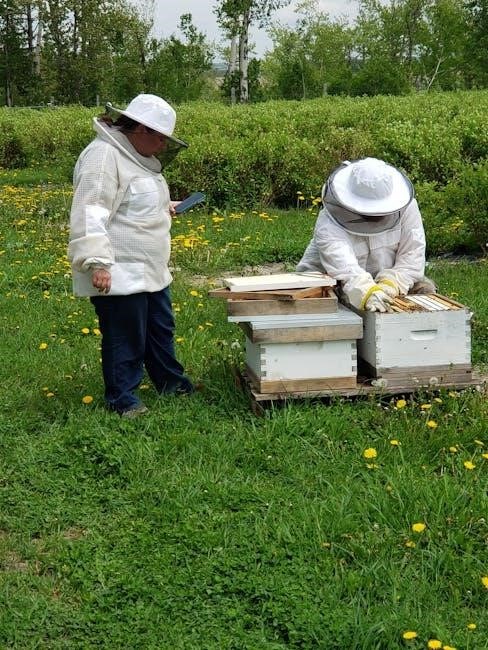
Free Hive Stand Plans and Resources
Free hive stand plans and resources are readily available online, offering detailed PDF guides for building durable and functional stands using materials like 2x4s and 4x4s, perfect for beekeepers of all skill levels.
11.1 Where to Find Reliable PDF Plans
Reliable PDF plans for bee hive stands can be found on beekeeping forums, DIY websites, and platforms like Bee Culture magazine. These plans often include detailed diagrams, materials lists, and step-by-step instructions. Many resources offer customizable designs, catering to different hive types, such as Langstroth or Top-Bar hives. Websites specializing in beekeeping equipment and DIY projects are excellent sources for free, downloadable guides tailored to various skill levels and preferences. Ensure the plans are from trusted sources to guarantee durability and functionality.
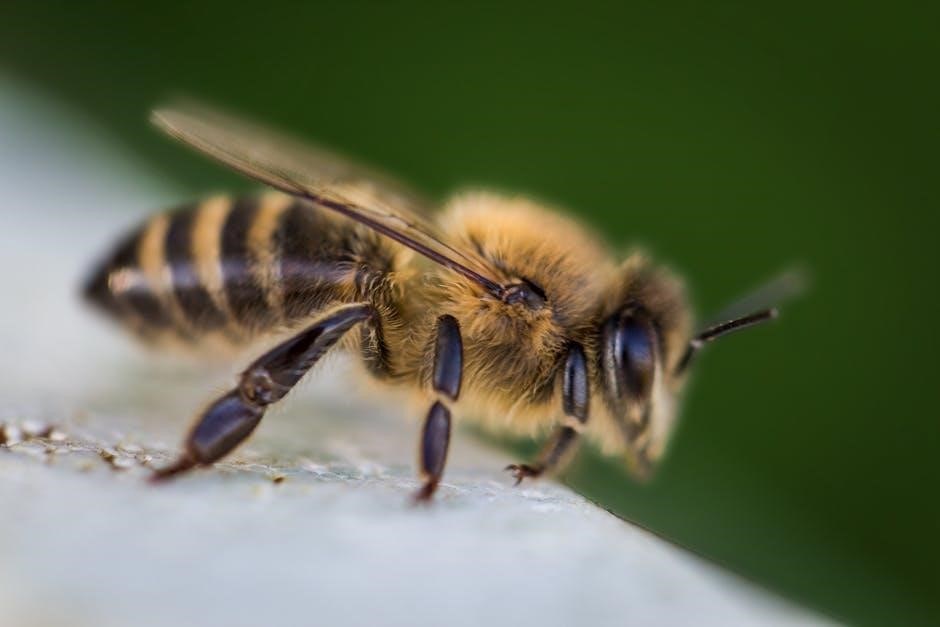
Common Mistakes to Avoid
Common mistakes include improper leveling, using untreated wood, and inadequate spacing. Ensure sturdy materials and precise measurements for stability and pest prevention, avoiding costly errors.
12.1 Design Flaws to Watch Out For
Design flaws to avoid include unstable legs, insufficient height, and lack of frame rests. Use pressure-treated lumber for durability and ensure proper spacing for multiple hives. Avoid uneven surfaces and poor material choices, as these can lead to hive instability and pest issues. Proper planning and precise measurements are crucial for a functional and safe hive stand.
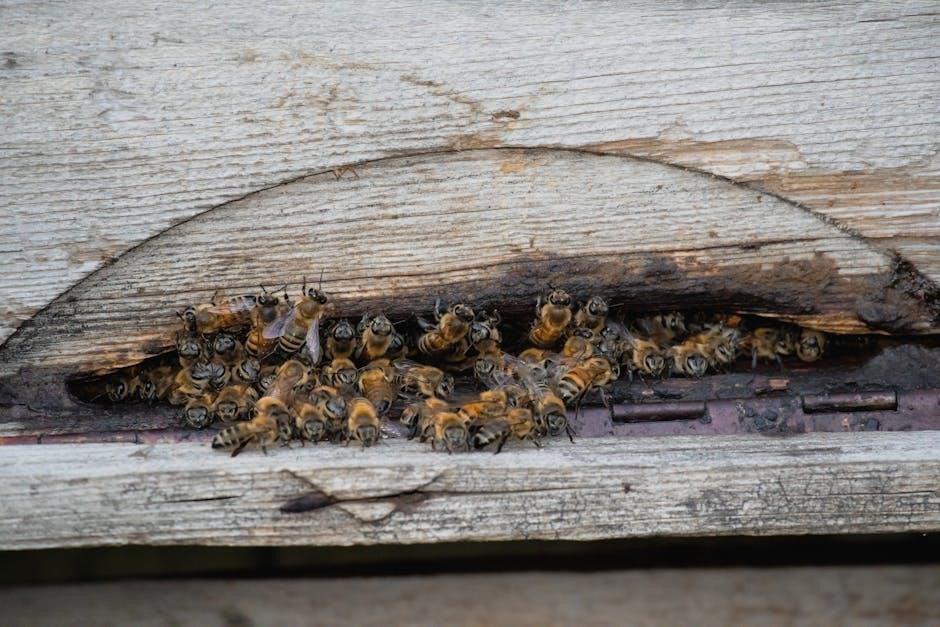
Regional and Climate-Specific Tips
Regional and climate-specific tips ensure hive stands adapt to local conditions. Use rot-resistant materials in damp areas and elevate stands in flood-prone regions. Adjust height for snow or pest concerns, and consider adding roofs in rainy climates to protect hives. These modifications enhance durability and bee health in varying environments.
13.1 Adjusting Hive Stand Designs for Local Conditions
When adapting hive stand designs for local conditions, consider materials resistant to moisture and pests. In coastal areas, use pressure-treated wood to prevent rot. In colder climates, raise stands higher to clear snow. For windy regions, reinforce leg stability. Ensure stands are level on uneven terrain and add shading in hot climates. These adjustments enhance hive durability and bee health locally.
A well-designed hive stand enhances beekeeping efficiency, protects hives from pests, and ensures durability. Refer to our PDF plans for practical guidance on building your ideal hive stand.
14.1 Final Thoughts on Building and Using Hive Stands
Constructing a hive stand is a straightforward yet impactful project for beekeepers. By using PDF plans, you can create a sturdy, elevated platform that protects hives from pests and moisture while improving accessibility. Ensure the stand is level and durable to support your bees’ needs. Regular maintenance and smart designs will enhance your beekeeping experience, making it both efficient and enjoyable for years to come.